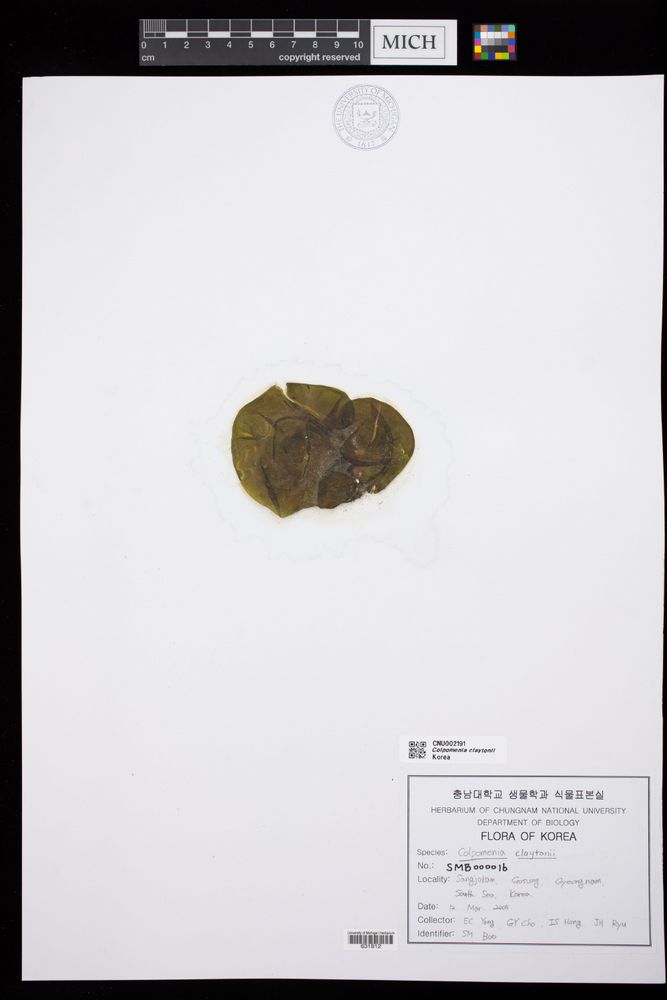Invasion History
First Non-native North American Tidal Record: 1999First Non-native West Coast Tidal Record: 1999
First Non-native East/Gulf Coast Tidal Record:
General Invasion History:
Colpomenia claytoniae was noted as an 'irregular, convoluted' form of C. peregrina in southeastern Australia by Clayton (1975). It was studied and recognized as a separate species, with a type specimen from Sangjokam, on the south coast of Korea. Specimens were collected from Korea; the Ryuku islands of Japan; Hong Kong; Port Philip Bay, Australia; New Zealand; and Cape Town, South Africa (Boo et al. 2011). We treated the species as a Northwest Pacific native, and the southern hemisphere populations as cryptogenic, but a broader Indo-Pacific native range is possible. Specimens of C. claytoniae were collected in southern California in 1999 and 2010 (Boo et al. 2011).
North American Invasion History:
Invasion History on the West Coast:
Colpomenia claytoniae was collected in 1999 in Corral Canyon State Beach, in Malibu, California, and again in 2010 in San Pedro, California (Boo et al. 2011). It was identified by microscopic and molecular methods. It is likely that this seaweed has a more extensive introduced range on the West Coast. Possible vectors include hull-fouling and ballast water.
Description
Colpomenia claytoniae grows as a bag-like or globular thallus, becoming irregular and convoluted with age. The thallus is covered by an outer cortex of angular, pigmented cells. There are extensive patches of plurilocular (multi-cell) sporangia having 6-8 locules (cells). The locules can be arranged in a single row (uniseriate) or biseriate. The thallus is attached at the base by rhizoid filaments.The thallus grows to 300 mm in diameter, and usually grows on rocks in the lower tide zone.. The thallus is tan to dark brown in color (Boo et al. 2011).
Taxonomy
Taxonomic Tree
| Kingdom: | Plantae | |
| Phylum: | Phaeophycophyta | |
| Class: | Phaeophyceae | |
| Order: | Scytosiphonales | |
| Family: | Scytosiphonaceae | |
| Genus: | Colpomenia | |
| Species: | claytonii |
Synonyms
Potentially Misidentified Species
Colpomenia bullosa occurs in mid-intertidal rocks around the North Pacific (Guiry and Guiry 2017). The tahllus has several finger-like divisions (Boo et al. 2011)
Colpomenia peregrina
Colpomenia peregrina is widely distributed in the Pacific, and is introduced in the Northeast and Northwest Atlantic (Nova Scotia-Cape Cod; Norway-Canary Islands-Mediterranean-Black Sea) (Guiry and Guiry 2016). It usually grows on plants and rarely on rocks, and occurs in the intertidal and subtidal zones. Its thalli are smaller than C. claytonii, 30-90 mm (Boo et al. 2011).
Colpomenia sinuosa
Colpomenia sinuosa is cosmopolitan in warm-temperate and tropical waters aound the world (Guiry and Guiry 2016). Its thallus is globose and vesicle-like but deeply folded, up to 140 cm in diameter. It usually grows on rocks, but sometimes on plants (Boo et al. 2011).
Colpomenia tuberculata
Colpomenia tuberculata is known from Alaska to Chile and Hawaii (Guiry and Guiry 2016).
Ecology
General:
Colpomenia claytoniae grows in its macroscopic phase as a globe or bag-like alga, which is found on rocks in lower intertidal zones. It has a two-phase diploid-haploid life cycle. The macroscopic phase are haploid gametophytes, producing male or female gametes. The female gametes settle onto a solid substrate, and male gametes fuse with them, growing into a short (~5 cells high) filamentous diploid sporophytes, 2-3 mm in diameter, resembling brown cushions (Clayton 1979). However, gametophytes can also release parthenogenetic haploid gametes, which develop without fertilization, and are morphologically identical to the sexually produced sporophytes. Terminal sporangia develop on the filaments, which produce zoospores, and settle and grow into the bag-like macroscopic thalli (Clayton 1979). Colpomenia claytoniae has been found on rocky substrates in the low intertidal zone in Korea, Australia, South Africa, and California (Boo et al. 2011). We do not have specific information on its temperature and salinity tolerances, or its light requirements.
Trophic Status:
Primary Producer
PrimProdHabitats
| General Habitat | Rocky | None |
| Salinity Range | Polyhaline | 18-30 PSU |
| Salinity Range | Euhaline | 30-40 PSU |
| Tidal Range | Low Intertidal | None |
| Vertical Habitat | Epibenthic | None |
Life History
Tolerances and Life History Parameters
| Maximum Length (mm) | 300 | Boo et al. 2011 |
| Broad Temperature Range | None | Cold temperate-Warm temperate |
| Broad Salinity Range | None | Polhaline-Euhaline |
General Impacts
The abundance and distribution of Colpomenia claytoniae on the West Coast are poorly known, and no impacts have been reported.
Regional Distribution Map
| Bioregion | Region Name | Year | Invasion Status | Population Status | Vectors |
|---|---|---|---|---|---|
| P050 | San Pedro Bay | 2010 | Non-native | Established | |
| P061 | _CDA_P061 (Los Angeles) | 1999 | Non-native | Established | |
| NEP-VI | Pt. Conception to Southern Baja California | 1999 | Non-native | Established | |
| NEP-V | Northern California to Mid Channel Islands | 1999 | Non-native | Established | |
| P080 | Monterey Bay | 1999 | Non-native | Established |
Occurrence Map
| OCC_ID | Author | Year | Date | Locality | Status | Latitude | Longitude |
|---|---|---|---|---|---|---|---|
| 760813 | Boo et al. 2011 | 1999 | Coral Street Beach, Pacific Grove | Non-native | 36.6355 | -121.9265 |
References
Fukuda, Tomoko; Kato, Yukie; Sato, Hiroyuki; Taran , Aleksan; r A. Barkalov, Vyacheslav Yu.; Takahashi, Hideki (2018) Naturalization of Cakile edentula (Brassicaceae) on the Beaches of Kunashiri and Etorofu Islands ― The First Record for the Species from the Kuril Islands, Japanese Journal of Malacology 88: 124-128Boo, Sung Min; Lee, Kyung Min; Cho, Ga Youn; Nelson, Wendy (2011) Colpomenia claytonii sp. nov. (Scytosiphonaceae, Phaeophyceae) based on morphology and mitochondrial cox3 sequences, Botanica Marina 54: 159-167
Clayton, Margaret N. (1975) A study of variation in Australian species of Colpomenia (Phaeophyta, Scytosiphonales), Phycologia 14(4): 187-195
Guiry, M. D.; Guiry, G. M. 2004-2023 AlgaeBase. https://www.algaebase.org/
